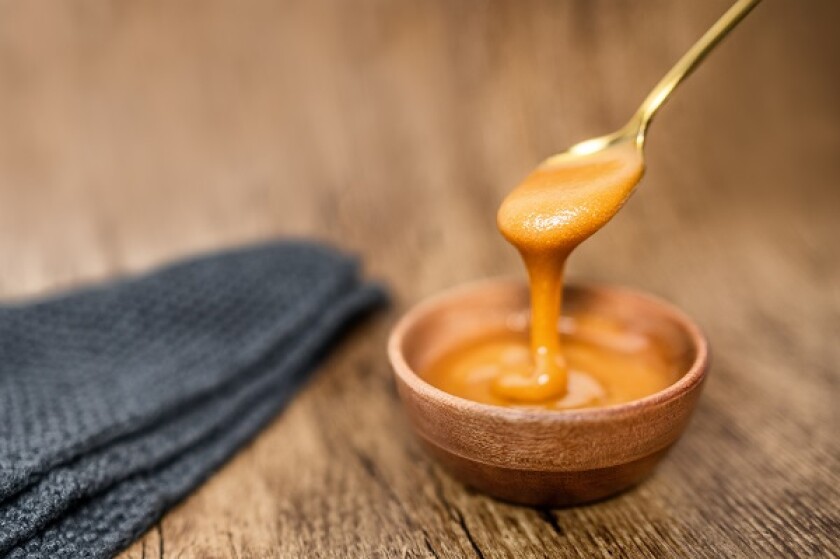Mānuka is the Māori name for the Leptospermum scoparium, a species of flowering plant in the myrtle family, Myrtaceae. Mānuka nectar is renowned for producing 'liquid gold', a pure honey possessing unique medicinal and antibacterial qualities.
Companies looking to capitalise on Mānuka honey's hefty price tag have used numerous celebrity endorsements to elevate the product worldwide. But while there are many Mānuka honey products on the market in Australia (produced in Australia, New Zealand and overseas), the New Zealand market for Mānuka honey is vastly different.
The New Zealand Ministry of Primary Industries prohibits the importation of any honey product, including Mānuka, into New Zealand, excluding a select few Pacific Island nations (https://www.mpi.govt.nz/importing/food/honey-and-bee-products/steps-to-importing/) where the Leptospermum scoparium is classified as a high risk weed (https://www.cabi.org/isc/datasheet/30097). Consequently, the only Mānuka honey available for sale in New Zealand is of New Zealand origin.
Sweet success
Given the increasing popularity, demand and associated price tag of Mānuka honey, it is unsurprising that New Zealand's Mānuka honey industry is fiercely protective of the commodity and wants to maintain control over the term Mānuka. The Mānuka Honey Appellation Society Incorporated (MHAS), a New Zealand society dedicated to securing ownership of the Mānuka trademark in New Zealand and overseas for New Zealand honey producers, filed New Zealand Trade Mark Application No. 1025914 "Manuka Honey" on August 18 2015 (MHAS's Application). The application is for a certification mark.
Section 5(1) of the New Zealand Trade Marks Act 2002 defines a certification trademark as a sign capable of distinguishing, in the course of trade, goods and/or services which are certified as having some special characteristic. In the case of goods, this might include for example, a certification that the following apply:
The goods stem from a specific geographical location (such as New Zealand).
The goods are produced by a particular method.
The goods comply with certain quality standards.
Provisions like these exist in Australian trademark legislation as well.
On April 3 2018, the Intellectual Property Office of New Zealand (IPONZ) accepted MHAS's Application. Since then it has been (and remains), the subject of a lengthy opposition by the Australian Manuka Honey Association. A decision is still pending.
Sticky business
The move by MHAS to obtain a registered certification mark for "Manuka Honey" in New Zealand (and around the world) has angered many Australian honey producers. These producers also make honey derived from the Leptospermum scoparium plant and wish to market and sell their own products as Mānuka honey (both in New Zealand and elsewhere). The battle over Mānuka is a good case study highlighting the protection that certification marks can provide product owners.
On the one hand, it is in the public interest that consumers can reliably purchase recognised and reputable products with the assurance that they are authentic and, in the case of Mānuka honey as claimed by MHAS, true to the geographical environment in which they are produced. This is particularly important given many goods associated with certified brands are often retailed at higher price points than ordinary goods in the same class – Australian Mānuka honey, as New Zealanders would argue – or worse still, watered down versions of the product.
Producers of goods protected by registered certification trademarks also argue that they seek to preserve their industry and the traditional production methods and/or geographical origins associated with the product. MHAS argued in separate proceedings before IPONZ relating to the distinctiveness of "Manuka Honey" that the honey was first sold in New Zealand over a century ago (Manuka Honey Appellation Society Incorporated [2018] NZIPOTM 7 (March 20 2018), at 18) with the Leptospermum scoparium plant thought to have migrated from New Zealand to Australia by wind.
Sticking point
Aside from the benefits of securing a certification mark, similar honeys produced outside of New Zealand have no affiliation to Māori or the traditional healing methods used by Māori with various parts of the Leptospermum scoparium plant (Manuka Honey Appellation Society Incorporated [2018] NZIPOTM 7 (March 20 2018), 30-32), thereby raising serious concerns about the cultural appropriateness of using Mānuka in reference to these products.
Whilst honey produced from the Leptospermum scoparium plant growing in Australia may have similar properties to Mānuka honey, because it has no affiliation with Māori culture, it is argued that Mānuka is not an appropriate classification.
The assistant commissioner in the decision relating to the distinctiveness of the "Manuka Honey" mark stated:
"…the fact that honey is labelled as honey from the nectar of a well-known native tree, which is identified by a Māori name, is capable of indicating that the honey has a particular geographical origin (New Zealand)…" (Manuka Honey Appellation Society Incorporated [2018] NZIPOTM 7 (March 20 2018), 63). She went on to say that the need for existing and future traders to use the mark "…can be accommodated with a certification mark – in effect, existing and future traders transfer the mark to a collective body to manage. The purpose of doing this is usually to prevent the use of the mark by traders outside of the region" (Manuka Honey Appellation Society Incorporated [2018] NZIPOTM 7 (March 20 2018), 68).
The buzz continues
The importance of certification marks and the benefits that flow from them has been brought to centre stage, while the battle over the bees continues between New Zealand and Australian honey producers. We could wax lyrical about the far-reaching implications of MHAS securing protection of Mānuka as a certification mark, but whatever the outcome, it will certainly sting the honey industry one way or another.

|
Nicola Scheepers |
|

|
Shannon Fati |













